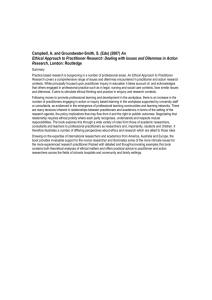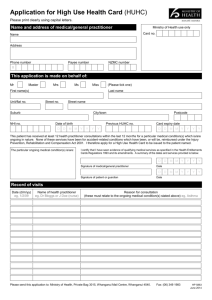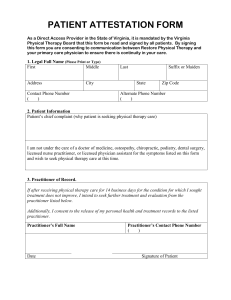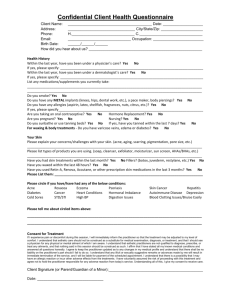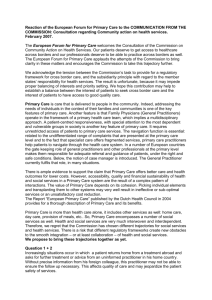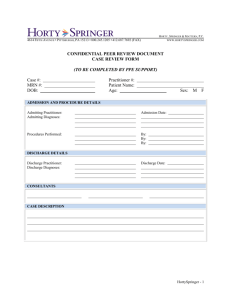Guidelines on the Keeping of Patient Records
advertisement
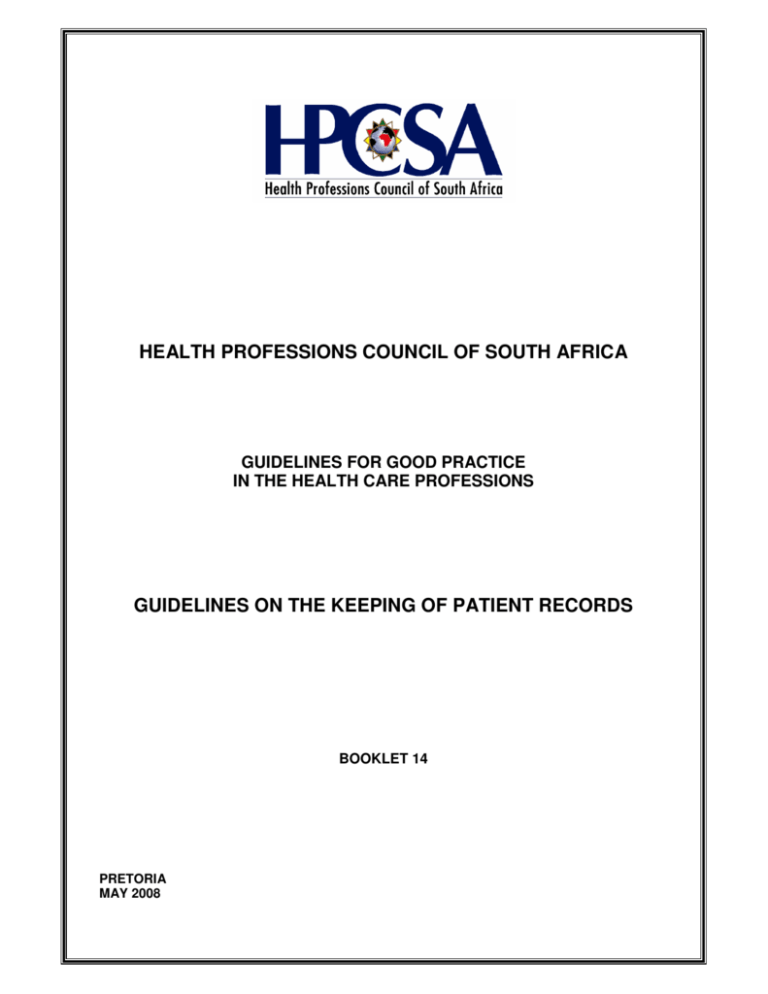
HEALTH PROFESSIONS COUNCIL OF SOUTH AFRICA GUIDELINES FOR GOOD PRACTICE IN THE HEALTH CARE PROFESSIONS GUIDELINES ON THE KEEPING OF PATIENT RECORDS BOOKLET 14 PRETORIA MAY 2008 ii Health Professions Council of South Africa Post Office Box 205 Pretoria 0001 Telephone: (012) 338 9300 Fax: (012) 328 4863 E-mail: hpcsa@hpcsa.co.za Website: http://www.hpcsa.co.za i THE SPIRIT OF PROFESSIONAL GUIDELINES Practice as a health care professional is based upon a relationship of mutual trust between patients and health care practitioners. The term “profession” means “a dedication, promise or commitment publicly made”.1 To be a good health care practitioner, requires a life-long commitment to sound professional and ethical practices and an overriding dedication to the interests of one’s fellow human beings and society. In essence, the practice of health care professions is a moral enterprise. In this spirit the HPCSA presents the following ethical guidelines to guide and direct the practice of health care practitioners. These guidelines form an integral part of the standards of professional conduct against which a complaint of professional misconduct will be evaluated. [Note: The term “health care practitioner” in these guidelines refers to persons registered with the HPCSA]. 1 Pellegrino, ED. Medical professionalism: Can it, should it survive? J Am Board Fam Pract 2000; 13(2):147-149 (quotation on p. 148). ii TABLE OF CONTENTS 1 DEFINITION OF A HEALTH RECORD ......................................................................... 1 2 WHAT CONSTITUTES A HEALTH RECORD? ............................................................ 1 3 WHY DOCUMENTS OR MATERIALS SHOULD BE RETAINED ................................. 1 4 COMPULSORY KEEPING OF RECORDS ................................................................... 2 5 SIGNING OF OFFICIAL DOCUMENTS ........................................................................ 2 6 CERTIFICATES AND REPORTS.................................................................................. 3 7 ISSUING OF PRESCRIPTIONS .................................................................................... 3 8 ALTERATION OF RECORDS ....................................................................................... 4 9 DURATION FOR THE RETENTION OF HEALTH RECORDS ...................................... 4 10 OWNERSHIP OF RECORDS ........................................................................................ 5 11 ACCESS TO RECORDS ............................................................................................... 6 12 RETENTION OF PATIENT RECORDS ON CD-ROM ................................................... 7 13 CHECKLIST FOR HEALTH RECORD-KEEPING ......................................................... 7 GUIDELINES ON THE KEEPING OF PATIENT RECORDS These guidelines are applicable to health care practitioners in private practice (including managed health care organisations), as well as to those in the employ of the public service. 1 DEFINITION OF A HEALTH RECORD A health record may be defined as any relevant record made by a health care practitioner at the time of or subsequent to a consultation and / or examination or the application of health management.2 A health record contains the information about the health of an identifiable individual recorded by a health care professional, either personally or at his or her direction.3 2 WHAT CONSTITUTES A HEALTH RECORD? 2.1 The following documents can be regarded as the essential components of a health record, obviously depending on the nature of the individual case: 2.1.1 Hand-written contemporaneous notes taken by the health care practitioner. 2.1.2 Notes taken by previous practitioners attending health care or other health care practitioners, including a typed patient discharge summary or summaries. 2.1.3 Referral letters to and from other health care practitioners. 2.1.4 Laboratory reports and other laboratory evidence such as histology sections, cytology slides and printouts from automated analysers, X-ray films and reports, ECG races, etc. 2.1.5 Audiovisual records such as photographs, videos and tape-recordings. 2.1.6 Clinical research forms and clinical trial data. 2.1.7 Other forms completed during the health interaction such as insurance forms, disability assessments and documentation of injury on duty. 2.1.8 Death certificates and autopsy reports. 2.2 The above records may be archived on microfilm, microfiche or magnetic data files. 3 WHY DOCUMENTS OR MATERIALS SHOULD BE RETAINED 3.1 Documents and materials should be retained in order to: 2 3 3.1.1 Further the diagnosis or ongoing clinical management of the patient; 3.1.2 Conduct clinical audits; 3.1.3 Promote teaching and research; de Klerk A. The right of patients to have access to their medical records: the position in South African law. Medical Law, Vol 12, 1993, pp. 77 - 83 Making and keeping medical records. MPS Casebook 13 (International), July 2000, 6-8 3.1.4 Be used for administrative or other purposes; 3.1.5 Be kept as direct evidence in litigation or for occupational disease or injury compensation purposes; 3.1.6 Be used as research data; 3.1.7 Be kept for historical purposes; 3.1.8 Promote good clinical and laboratory practices; 3.1.9 Make case reviews possible; 3.1.10 Serve as the basis for accreditation.4 4 COMPULSORY KEEPING OF RECORDS 4.1 Health care practitioners should enter and maintain at least the following information for each patient consulted: 4.1.1 Personal (identifying) particulars of the patient. 4.1.2 The bio-psychosocial history of the patient, including allergies and idiosyncrasies. 4.1.3 The time, date and place of every consultation. 4.1.4 The assessment of the patient’s condition. 4.1.5 The proposed clinical management of the patient. 4.1.6 The medication and dosage prescribed. 4.1.7 Details of referrals to specialists, if any. 4.1.8 The patient’s reaction to treatment or medication, including adverse effects. 4.1.9 Test results. 4.1.10 Imaging investigation results. 4.1.11 Information on the times that the patient was booked off from work and the relevant reasons. 4.1.12 Written proof of informed consent, where applicable. 4.2 Records should be kept in non-erasable ink and erasure fluid should not be used. 5 SIGNING OF OFFICIAL DOCUMENTS Rule 15 of the HPCSA’s ethical rules states that: “Any student, intern or practitioner who, in the execution of his or her professional duties, signs official documents relating to patient care, such as prescriptions, certificates(excluding death certificates) patient records, hospital or other reports, shall do so by signing such document next to his or her initials and surname in block letters.” 4 Royal College of Pathologists, Marks and Spencer Publications Unit. The retention and storage of pathological records and Archives, London, Royal College of Pathologists, 1995 6 CERTIFICATES AND REPORTS According to Rule 16 of the ethical guidelines: “(1) A practitioner shall only grant a certificate of illness if such certificate contains the following information, namely (a) the name, address and qualification of the practitioner; (b) the name of the patient; (c) the employment number of the patient (if applicable); (d) the date and time of the examination; (e) whether the certificate is being issued as a result of personal observations by the practitioner during an examination, or as the result of information received from the patient and which is based on acceptable medical grounds; (f) a description of the illness, disorder or malady in layman's terminology with the informed consent of the patient: Provided that if the patient is not prepared to give such consent, the medical practitioner or dentist shall merely specify that, in his or her opinion based on an examination of the patient, the patient is unfit to work; (g) whether the patient is totally indisposed for duty or whether the patient is able to perform less strenuous duties in the work situation; (h) the exact period of recommended sick leave; (i) the date of issuing the certificate of illness; and (j) a clear indication of the identity of the practitioner who issued the certificate which shall be personally and originally signed by him or her next to his or her initials and surname in printed or block letters. (2) If preprinted stationery is used, a practitioner shall delete words which are irrelevant. (3) A practitioner shall issue a brief factual report to a patient where such a patient, requires information concerning himself or herself.” 7 ISSUING OF PRESCRIPTIONS On the issuing of prescriptions, Rule 17 states that: “A practitioner (a) shall be permitted to issue typewritten, computer-generated, pre-typed, preprinted or standardised prescriptions for medicine scheduled in schedules I, II, III and IV of the Medicines and Related Substances Control Act, 1965 (Act No. 101 of 1965), subject thereto that such prescriptions may only be issued under his or her personal and original signature; (b) shall issue handwritten prescriptions for medicine scheduled in schedules 5,6,7 and 8 above of the Act referred to in paragraph (a) under his or her personal and original signature (see also rule 14).” 8 ALTERATION OF RECORDS 8.1 No information or entry may be removed from a health record. 8.2 An error or incorrect entry discovered in the record may be corrected by placing a line through it with ink and correcting it. The date of change must be entered and the correction must be signed in full. The original record must remain intact and fully legible. 8.3 Additional entries added at a later date must be dated and signed in full. 8.4 The reason for an amendment or error should also be specified on the record. 9 DURATION FOR THE RETENTION OF HEALTH RECORDS 9.1 Health records should be stored in a safe place and if they are in electronic format, safeguarded by passwords. Practitioners should satisfy themselves that they understand the HPCSA’s guidelines with regard to the retention of patient records on computer compact discs. 9.2 Health records should be stored for a period of not less than six (6) years as from the date they became dormant. 9.3 In the case of minors and those patients who are mentally incompetent, health care practitioners should keep the records for a longer period: 9.3.1 For minors under the age of 18 years health records should be kept until the minor’s 21ST birthday because legally minors have up to three years after they reach the age of 18 years to bring a claim. This would apply equally for obstetric records. 9.3.2 For mentally incompetent patients the records should be kept for the duration of the patient’s lifetime. 9.4 In terms of the Occupational Health and Safety Act (Act No. 85 of 1993) health records must be kept for a period of 20 years after treatment. 9.5 Notwithstanding the provisions in paras 9.3 and 9.4 above, the health records kept in a provincial hospital or clinic shall only be destroyed if such destruction is authorised by the Deputy Director-General concerned. 9.6 In addition to the time periods mentioned above there are a number of other factors that may require health records to be kept for longer periods, but no clear-cut rules exist in this regard. For instance, certain health conditions take a long period to manifest themselves, (e.g.asbestosis), and records of patients who may have been exposed to such conditions, should be kept for a sufficient period of time. The HPCSA recommends that this should not be less than 25 years. 9.7 A balance must be reached between the costs of (indefinite) retention of records (in terms of space, equipment, etc.) and the occasional case where the practitioners’ defence of a case of negligence is handicapped by the absence of records. The value of the record for academic or research purposes, and the risks resulting from the handling or complications of the case, are additional considerations. 9.8 Where there are statutory obligations that prescribe the period for which patient records should be kept, a practitioner must comply with these obligations. 10 OWNERSHIP OF RECORDS 10.1 In the case of state institutions, where records e.g radiographs are the property of the institution, original records and images should be retained by the institution. Copies must however, be made available to the patient (or referring practitioner) on request for which a reasonable fee may be charged in terms of the Promotion of Access to Information Act (Act No. 2 of 2000); 10.2 In cases where patients are required to pay for records and images (e.g. private patients or patients in private hospitals) such patients must be allowed to retain such records - unless the health care practitioners deem it necessary to retain such records for purpose of monitoring treatment for a given period. Should the patient however require the records and / or images to further or protect an interest (e.g. such as consulting with another practitioner) he or she must be allowed to obtain the originals for these purposes. 10.3 As the ownership of records in a multi-disciplinary practice depends on the legal structure of the practice, the governing body of such multi-disciplinary practice should ensure that these guidelines and the provisions of the Promotion of the Access to Information Act relating to health records are adhered to. The Act requires public institutions to appoint information officers to administer access to information, and similar provisions apply to private bodies. 10.4 Should a health care practitioner in private practice (both in a single practice and in a partnership) pass away, his or her estate, which includes the records, will be administered by the executor of the estate: 10.5 10.4.1 Should a practice be taken over by another health care practitioner, the executor shall carry over the records to the new health care professional. The new health care practitioner is obliged to take reasonable steps to inform all patients regarding the change in ownership and that the patient could remain with the new health care practitioner or could request that his or her records be transferred to another health care practitioner of his or her choice. 10.4.2 Should the practice not be taken over by another health care practitioner the executor should inform all patients in writing accordingly and transfer those records to other health care practitioners as requested by individual patients. The remaining files should be kept in safe keeping by the executor for a period of at least twelve (12) months with full authority to further deal with the files as he or she may deem appropriate - provided the provisions of the rules on professional confidentiality are observed. 10.4.3 It should be noted that certain partnership agreements may make specific provision for the management of a deceased partner’s share in the partnership after the death of a partner and such management would include dealing with patient records. If health care practitioners in private practice decide to close their practice for whatever reason they shall within three months of closure inform all their patients in writing that: 10.5.1 The practice is being closed as from a specific date; 10.5.2 Requests may be made that records are transferred to other health care practitioners of their choice; 10.5.3 After the date concerned, the records will be kept in safe-keeping for a period of at least twelve (12) months by an identified health care practitioner or health institution with full authority to deal with the files as he or she may deem appropriate, provided the provisions of the rules on professional confidentiality are observed. 11 ACCESS TO RECORDS 11.1 In terms of the law the following principles apply in regard to access to information in health records: 11.2 11.3 11.1.1 A health care practitioner shall provide any person of age 12 years and older with a copy or abstract or direct access to his or her own records regarding medical treatment on request (Children’s Act (Act No. 38 of 2005)). 11.1.2 Where the patient is under the age of 16 years, the parent or legal guardian may make the application for access to the records, but such access should only be given on receipt of written authorization by the patient (Access to Information Act (Act No. 2 of 2000)). 11.1.3 Information about termination of a pregnancy may not be divulged to any party, except the patient herself, regardless of the age of the patient (Choice on Termination of Pregnancy Act (Act No. 92 of 1996)). 11.1.4 No health care practitioner shall make information available to any third party without the written authorisation of the patient or a court order or where nondisclosure of the information would represent a serious threat to public health (National Health Act (Act 61 of 2003)). A health care practitioner may make available the records to a third party without the written authorisation of the patient or his or her legal representative under the following circumstances: 11.2.1 Where a court orders the records to be handed to the third party; 11.2.2 Where the third party is a health care practitioner who is being sued by a patient and needs access to the records to mount a defence. 11.2.3 Where the third party is a health care practitioner who has had disciplinary proceedings instituted against him or her by the HPCSA and requires access to the records to defend himself or herself. 11.2.4 Where the health care practitioner is under a statutory obligation to disclose certain medical facts, (e.g. reporting a case of suspected child abuse in terms of the Children’s Act, (Act No. 38 of 2005)). 11.2.5 Where the non-disclosure of the medical information about the patient would represent a serious threat to public health (National Health Act (Act No. 61 of 2003)). In provincial hospitals medical records must be kept under the care and control of the clinical manager. Access to such records shall be subject to compliance with the requirements of the Access to Information Act and such conditions as may be approved by the superintendent. 12 RETENTION OF PATIENT RECORDS ON CD-ROM 12.1 Storage of clinical records on computer compact disc (CD-ROM) is permissible, provided that protective measures are in place: 13 12.1.1 Only CD-ROM technology that is designed to record a CD once only, so that old information cannot be overwritten, but new information can be added is used; 12.1.2 All clinical records stored on computer compact disc and copies thereof are to be encrypted and protected by a password in order to prevent unauthorised persons to have access to such information; 12.1.3 A copy of the CD-ROM to be used in the practitioner’s rooms will be in a readonly format; 12.1.4 A back-up copy of the CD-ROM must be kept and stored in a physically different site in order that the two discs can be compared in the case of any suspicion of tampering; 12.1.5 Effective safeguards against unauthorised use or retransmission of confidential patient information must be assured before such information was entered on the computer disc. The right of patients to privacy, security and confidentiality must be protected at all times. CHECKLIST FOR HEALTH RECORD-KEEPING Good notes imply good practice and the following checklist may serve to guide health care practitioners in the appropriate keeping of patient records:5 13.1 Records should be complete, but concise. 13.2 Records should be consistent. 13.3 Self-serving or disapproving comments should be avoided in patient records. Unsolicited comments should be avoided (i.e. the facts should be described, and conclusions only essential for patient care made). 13.4 A standardised format should be used (e.g. notes should contain in order the history, physical findings, investigations, diagnosis, treatment and outcome.). 13.5 If the record needs alteration in the interests of patient care, a line in ink should be put through the original entry so that it remains legible; the alterations should be signed in full and dated; and, when possible, a new note should refer to the correction without altering the initial entry. 13.6 Copies of records should only be released after receiving proper authorisation. 13.7 Billing records should be kept separate from patient care records. 13.8 Attached documents such as diagrams, laboratory results, photographs, charts, etc. should always be labelled. Sheets of paper should not be identified simply by being bound or stapled together – each individual sheet should be labelled. 5 Adapted from Torres, A, Proper S.: Medico-legal developments and the Dermatologist. Advances in Dermatology, Vol 12, 1987 Ethical guidelines for good practice in the health care professions The following Booklets are separately available: Booklet 1: General ethical guidelines for health care professions Booklet 2: Ethical and professional rules of the health professions council of South Africa as promulgated in government gazette R717/2006 Booklet 3: National Patients’ Rights Charter Booklet 4: Professional self-development Booklet 5: Guidelines on over servicing, perverse incentives and related matters Booklet 6: General ethical guidelines for health researchers Booklet 7: Ethical Guidelines for Biotechnology Research in South Africa Booklet 8: Research, development and the use of the chemical, biological and nuclear capabilities of the State Booklet 9: Seeking patients’ informed consent: The ethical considerations Booklet 10: Confidentiality: Protecting and providing information Booklet 11: Guidelines for the management of patients with HIV infection or AIDS Booklet 12: Booklet 13: Booklet 14: Guidelines withholding and withdrawing treatment Guidelines on Reproductive Health management Guidelines on Patient Records Booklet 15: Canvassing of patients abroad Booklet 16: Guidelines for the management of health care waste


